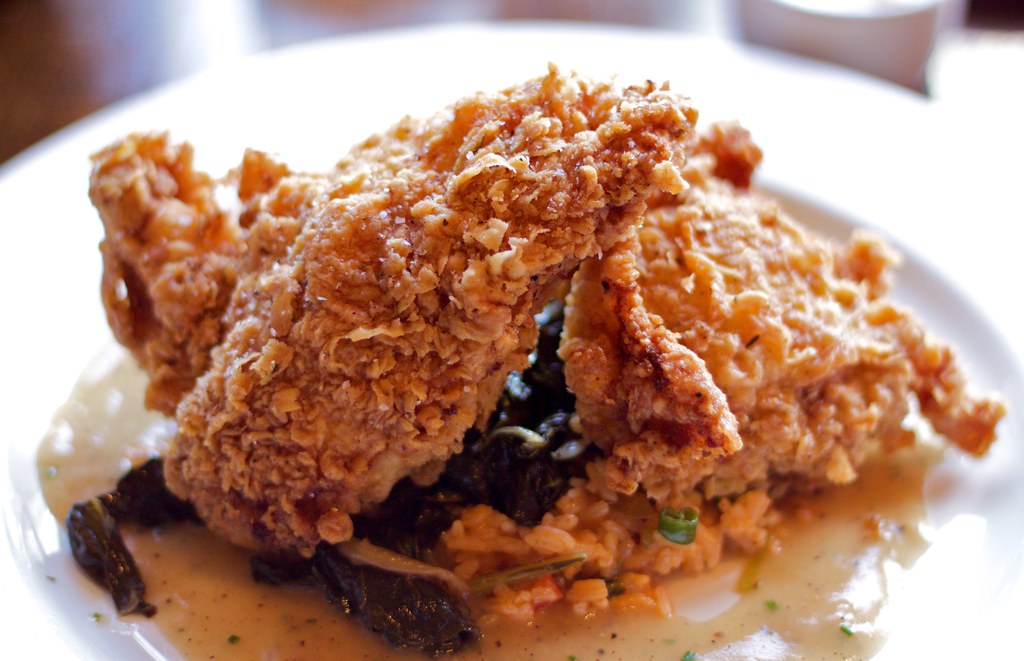In the movie Green Book, the 2019 Academy Award winner for Best Picture, Tony Vallelonga introduces fried chicken to the famed pianist Don Shirley for the first time on the road. To the skeptical Dr. Shirley, Tony responds, “You know my father used to say, ‘Whatever you do, do it a hundred percent. When you work––work. When you laugh––laugh. When you eat, eat like it’s your last meal!’” When asked what to do with the remaining bones, Tony casually throws them out the car window. The scene marks both Shirley’s deviation from his usual lifestyle and the beginning of the pair’s unlikely friendship.
And in the midst of it all?
Fried chicken.
The National Chicken Council estimates that the average American consumed 101 pounds of chicken in 2023, a staggering amount compared to beef and pork with only 58 and 50, respectively. And of this massive chicken consumption, fried chicken seems to be one of the more meaningful ways to consume it. In Japan, for example, it has become a tradition for some to have a family KFC dinner every Christmas, leading KFC to pull in $63 million in the five days leading up to Christmas in 2018. In a similar traditional sense, 1.25 billion chicken wing portions were eaten during the 2012 Super Bowl weekend. Fried chicken is loved internationally with countless preparations in countless countries. However mundane and ordinary a dish it may seem, fried chicken is rich with culture and history that people often overlook. It is a food that carries meaning beyond itself, not just in America, but across the globe.
In the history of the United States, fried chicken once stood as a symbol of financial liberation and independence for marginalized communities. In 1692, in an attempt to prevent bought liberation from slavery, the Virginia General Assembly prohibited slaves from owning horses, cattle, or pigs. But because the law never explicitly mentioned chickens, African-Americans began raising and trading them. Therefore, as time went on, chickens became an important part of the Southern plantation economy for slaves. As one of the few modes of financial independence granted to slaves, chicken granted them a sliver of independence and allowed a unique culture to develop. And soon enough, African-Americans began frying the chickens in oil, marking the beginning of Southern fried chicken. Similarly, in the late 1800s, in a major railroad stop in Virginia named Gordonsville, black women began selling fried chicken to the train passengers. Because of its convenience and stability, fried chicken was the perfect food for the bustling atmosphere. Soon enough, many black families were able to move out of the area and build their own homes as a result, cementing Gordonsville as the “Fried Chicken Capital of the World.” In this case, fried chicken was once again present to act as a symbol of financial independence, by aiding African-American families in building their own homes.
As fried chicken became more popular in the South, it cemented itself as a staple dish for special occasions. Specifically, it became common to serve fried chicken during gatherings in black churches. The dish would thereby earn the nicknames “Gospel Bird” and “Sunday Cluck,” demonstrating its prominence in religious fellowship. As such, fried chicken played a key role in building communal relationships, allowing people to come together and bond at religious gatherings. Furthermore, the influence of fried chicken goes beyond just the United States; it connects different culinary traditions of multiple different countries. Each country has their own version of the dish, including—but not limited to—Japan’s karaage, Taiwan’s yan su ji, Indonesia and Malaysia’s ayam goreng, Austria’s backhendl, and India’s chicken 65. Fried chicken is a dish that reaches across all cultures, providing a common ground in culinary tradition and bringing people together.
From symbolizing financial independence to building a strong community, fried chicken is a quintessential part of American and global culture. With that said, despite its profound cultural and historical significance, fried chicken is frequently dismissed—a disregard that underscores the need for a more nuanced appreciation of its symbolic and communal value. Fried chicken encapsulates a simplicity and complexity that can only be described as magic. Its rich prominence in history and culture both in the past and present makes the dish significant to our lives in ways we might not realize.
On your way out, enjoy a poem I wrote a couple years back:



